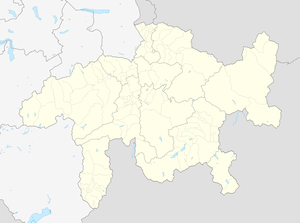Brusio circular viaduct
Coordinates: 46 ° 15 ′ 14 " N , 10 ° 7 ′ 40" E ; CH1903: eight hundred and seven thousand three hundred thirty / 126049
| Brusio circular viaduct | ||
|---|---|---|
| View of the circular viaduct from the southwest | ||
| Official name | Viadotto elicoidale di Brusio | |
| use | Railway bridge | |
| Convicted | Bernina Railway | |
| place | Brusio | |
| Entertained by | Rhaetian Railway | |
| construction | Arch bridge , viaduct | |
| overall length | 142.80 m | |
| width | 4.88 m | |
| Number of openings | 9 | |
| Longest span | 10 m | |
| height | 7-17 m | |
| start of building | 1907 | |
| opening | July 1, 1908 | |
| location | ||
|
|
||
| Above sea level | 705 m above sea level M. | |
The circular viaduct of Brusio ( Italian Viadotto elicoidale di Brusio ) is a single-track, looped railway - Viaduct of the Rhaetian Railway (RhB). It is located near Brusio in the canton of Graubünden . This landmark of the meter-gauge Bernina Railway running through the Poschiavo is part of the UNESCO World Heritage .
description
The structure is located on the southern outskirts of Brusio, about 600 meters from the train station at an altitude of about 705 m above sea level. M. The length is 142.80 m, the bridge width 4.88 m. Each of the nine arches has a span of 10 m. With a track radius of 70 m and a slope of 70 ‰, the valley floor is crossed at a height of 7 to 17 m. In numerous publications the length of the structure is given as 110 meters; however, this only affects the bridge itself and excludes the dam that goes with it.
history
The Buss project for a Bernina railway from June 1905 (approved by the Federal Council on March 2, 1906) envisaged a maximum gradient of 7% and therefore required a route independent of the steeper road between Miralago and Campocologno. The location of the stations in the municipality of Brusio was controversial, as there was also no agreement in the municipality with its parliamentary groups. So, although the construction of the undisputed sections between Tirano and Poschiavo began in May 1906, variants still had to be looked for in the Brusio area.
A variant of the project dated August 6, 1906 provided for a Brusio station below the village. In the area of today's viaduct an S-loop was planned, which consisted of a paved embankment and which contained a counter curve with a radius of 50 m on both sides. The station would have been below the loop.
At the request of the municipality of Brusio, a project variant was presented on September 26, 1906, which envisaged the Brusio train station at the current location above the village, supplemented by a Campascio stop. The loop to gain length remained, however, instead of the dam, a bridge with 8 arches 10 m wide is planned. The S-curve now has radii of 45 m.
An open loop that leads back under the viaduct, the "circular viaduct", can be found for the first time in a variant dated October 29, 1906, approved by the railway department on December 21, 1906. The reason for this solution may have been the reduced land requirement.
The delays at Brusio train station led to time pressure. Construction on the Brusio viaduct began on March 25, 1907, when the route from Campocologno to the viaduct was already completed. Nevertheless, the Tirano-Poschiavo line was completed in July 1908.
On December 14, 2008, a large rock fall occurred above the circular viaduct, whereupon the railway line was closed for 111 days due to the massive destruction (overhead lines, rails, track bed, embankment). Due to the unstable geology, a collecting dam was built to hold back falling rock in such a way that no more material can reach the railway systems.
The circular viaduct was extensively renovated from March to October 2011, as large temperature differences and chemical decomposition over the decades had caused considerable damage to the masonry in the area of the arched vaults. The RhB built watertight ballast troughs in reinforced concrete while the work was still going on, for which the top 80 cm of the circular viaduct had to be completely removed. This also involved widening both sides by 23 cm. The costs amounted to 2.75 million Swiss francs. In another rock fall above the circular viaduct on January 8th and 9th, 2013, the protective dam built in 2009 proved its worth, so this time the damage was far less and the traffic was already back on February 17th - despite a longer interruption of the clean-up work due to the winter weather could be included.
Others
A replica of the circular viaduct of Brusio exists in Nuevo Arenal in Costa Rica at the Tren Turistico Arenal in the hotel complex Pequeña Helvecia . A narrow-gauge railway with a gauge of 600 mm runs over a 3.5-kilometer route there.
See also
Web links
Individual evidence
- ↑ a b Red circular viaduct as an eye-catcher. Rhaetian Railway , May 16, 2011, accessed on August 24, 2015 .
- ↑ E. Bosshard: The Bernina Railway . In: Schweizerischer Ingenieur- und Architektenverein (Ed.): Schweizerische Bauzeitung . tape LIX , no. 8 . Zurich, February 24, 1912, p. 99-102 , doi : 10.5169 / seals-29940 ( online ).
- ↑ Annual Report 2009 (PDF, 6.1 MB) Rhaetian Railway , 2009, accessed on August 24, 2015 .
- ↑ The RhB trains will start running again on Sunday. Southeastern Switzerland , February 15, 2013, accessed on August 24, 2015 .
- ^ Costa Rica at Friends of Latin American Railways, accessed February 27, 2019


